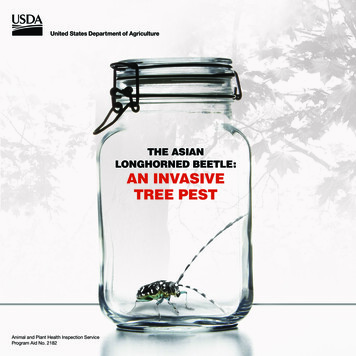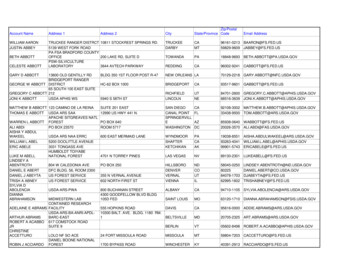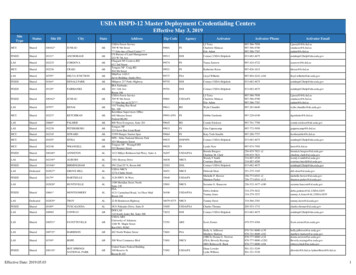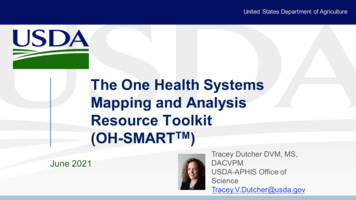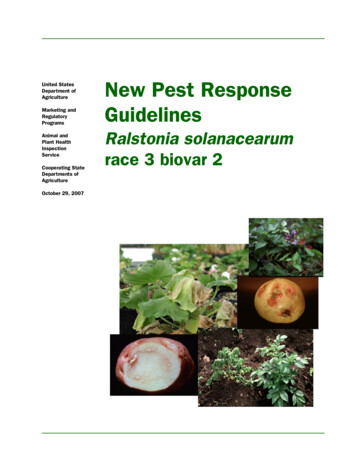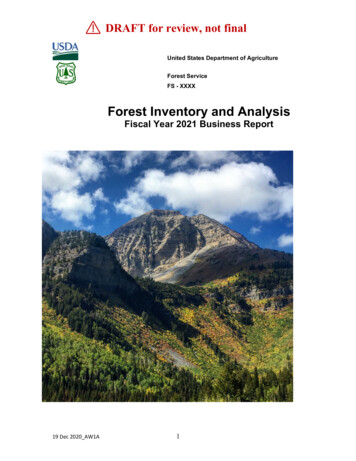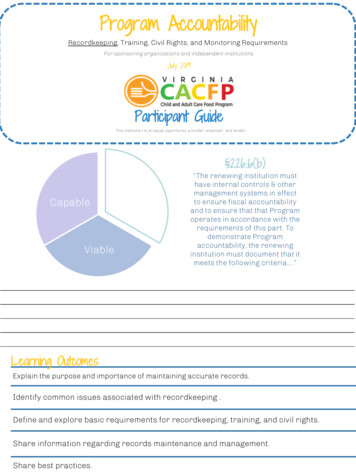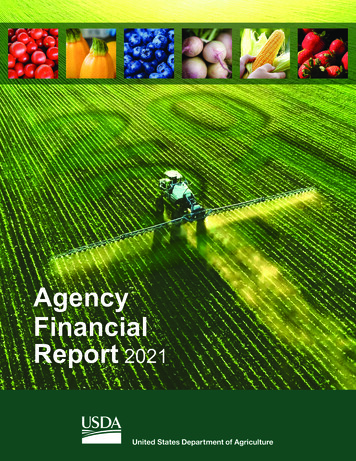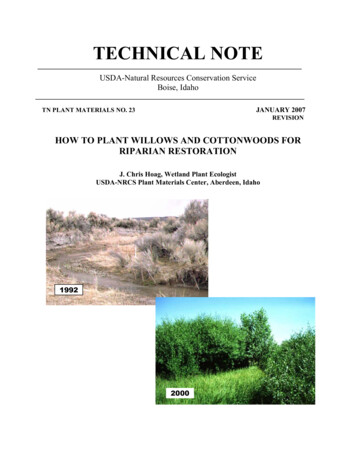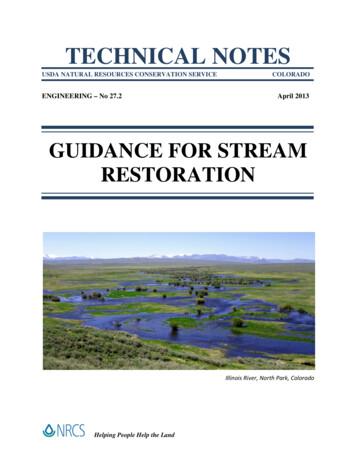
Transcription
TECHNICAL NOTESUSDA NATURAL RESOURCES CONSERVATION SERVICEENGINEERING – No 27.2COLORADOApril 2013GUIDANCE FOR STREAMRESTORATIONIllinois River, North Park, ColoradoHelping People Help the Land
Advisory Note:Techniques and approaches contained in thishandbook are not all-inclusive, nor universallyapplicable. Designing stream restorationsrequires appropriate training and experience,especially to identify conditions where variousapproaches, tools, and techniques are mostapplicable, as well as their limitations for design.Note also that product names are included onlyto show type and availability and do notconstitute endorsement for their specific use.The U.S. Department of Agriculture (USDA)prohibits discrimination against its customers. Ifyou believe you experienced discrimination whenobtaining services from USDA, participating in aUSDA program, or participating in a programthat receives financial assistance from USDA,you may file a complaint with USDA. Informationabout how to file a discrimination complaint isavailable from the Office of the AssistantSecretary for Civil Rights.USDA prohibits discrimination in all itsprograms and activities on the basis of race,color, national origin, age, disability, and whereapplicable, sex (including gender identity andexpression), marital status, familial status,parental status, religion, sexual orientation,political beliefs, genetic information, reprisal, orbecause all or part of an individual’s income isderived from any public assistance program. (Notall prohibited bases apply to all programs.)To file a complaint of discrimination, complete,sign and mail a program discriminationcomplaint form, available at any USDA officelocation or online at www.ascr.usda.gov, or writeto:USDAOffice of the Assistant Secretary for Civil Rights1400 Independence Avenue, S.W.Washington, D.C. 20250-9410Or call toll free at (866) 632-9992 (voice) toobtain additional information, the appropriateoffice or to request documents. Individuals whoare deaf, hard of hearing or have speechdisabilities may contact USDA through theFederal Relay service at (800) 877-8339 or (800)845-6136 (in Spanish). USDA is an equalopportunity provider, employer and lender.Persons with disabilities who require alternativemeans for communication of programinformation (e.g., Braille, large print, audiotape,etc.) should contact USDA's TARGET Center at(202) 720-2600 (voice and TDD).USDA NRCSGuidance for Stream RestorationCO-TN-ENG-27.2iiDenver, COApril 2013
ACKNOWLEDGEMENTSThis technical note was written by StevenYochum, PhD, PE, Hydrologist, NRCSColorado. The initial version (27.1) wasreleased in June 2012.Peer review was performed by Rob Sampson,PE, State Conservation Engineer, NRCSIdaho; Barry Southerland, PhD, FluvialGeomorphologist, NRCS West NationalTechnology Support Center; Brian Bledsoe,PhD, PE, Associate Professor of Civil andEnvironmental Engineering, Colorado StateUniversity; Terri Sage, Biologist, NRCSColorado; Christine Taliga, Plant MaterialsSpecialist, NRCS Colorado.CONTENTSINTRODUCTION . . 1GOALS AND OBJECTIVES . . 2GENERAL METHODS . . 3Interdisciplinary Team . 3Planning Process . . 3Watershed Approach . . 4Riparian Management . 5Adaptive Management . . 5Extent of Design and Review . . 7OVERVIEW OF STREAM PROCESSES . 8CASE STUDIES . . 9FISH OF CONCERN IN COLORADO . 10DATA COMPILATION . 11Data Sources 11Water Quantity . 11Water Quality 11GIS Data and Mapping . . 11Climate Data . 11Vegetative Information . 12Literature . 12Geographic Information System (GIS). 12Historical Information . 12PRELIMINARY ASSESSMENT . 13Basic Assessment Tools . 14Stream Classification . . 14Channel Evolution Model 16FIELD DATA COLLECTION . 17Topographic Survey Data 17Bankfull Identification . 18Discharge Measurements . 18Water Quality . 19Bed Material Sampling . 20USDA NRCSGuidance for Stream RestorationSediment Transport Measurements . 20Riparian Vegetation . 21Aquatic Resources 22ANALYSES FOR STREAMRESTORATION . 23Bankfull and Channel-FormingDischarge . 23Flow Frequency Estimates . 24Rosgen Geomorphic Channel Design . 26Soar and Thorne Restoration Design . 28Hydraulic Modeling Overview . 29Modeling Tools . 30Hydraulic Analysis andAquatic Habitat . 30Bank/Bed Stability and Sediment . 31Environmental Flows . . 31Watershed Modeling . 31Flow Resistance Estimation . 32General Guidance 32Low-Gradient Channels 32Mid-Gradient Channels . . 33High-Gradient Channels . 33Floodplains . 33RESTORATION DESIGN FEATURES . 34Vegetation 34Livestock Grazing Management . 36Bank Stabilization . 38Stream Barbs 39Vanes . . . 40Bendway Weirs . 40Spur Dikes . 41Toe Wood . 41Soil Bioengineering . 41Rock Walls . 42Rip rap . 42Bed Stabilization and StreamDiversions 43Planform Design . 45Instream Wood 45Fish Habitat and Environmental Flows. 47Fish Passage 50Fish Screening . 52Dam Removal . 52Beavers 52MONITORING AND REPORTING . 54SUMMARY . 54REFERENCES . 55APPENDIX A: Table of Contents for NRCSNEH Part 654 . 64APPENDIX B: Glossary of FluvialGeomorphology Terms . 65CO-TN-ENG-27.2iiiDenver, COApril 2013
36: Variable descriptions for U-vanestage-discharge rating . 4437: Schematic illustrating variablesdescribing channel planformcharacteristics . 4538: Substantial instream wood loading ina high-gradient stream channel . 4639: Railroad tie drives . 4640: LUNKERS installation . . 4841: Culvert outlet drop . . 5042: Pool and weir fishway . 5143: Fixed, inclined fish screen 5244: Beaver-dominated streamcorridor . 5345: Beaver deceiver . . 5346: Beaver baffler . 53FIGURESFigure 1: Planning process . . 32: The three primary NRCSconstituents . . 43: Project screening matrix . 74: Levels of stability assessments 145: Montgomery and Buffingtonclassification system 156: Rosgen classification system . 157: Channel cross sections illustratingthe 5 CEM classes . 168: Various possible stream successionstages 169: Differential surveying . . 1710: Survey-grade GPS 1711: Diurnal temperature fluctuations. 1912: Bed material particle sizedistribution . 2013: Bedload trap . 2114: Vegetation zones within a ripariancross section . 2115: Fish sampling . . 2216: Macroinvertebrate samplingequipment 2217: Effective discharge computation. 2418: Flow frequency estimates . 2519: Annual peak discharge trends . 2520: Schematic illustrating the RosgenGeomorphic Channel Designmethod . 2721: Soar and Thorne (2001) streamrestoration design procedure 2822: Analytical channel design using theCopeland method . 3023: Computation methodology for 𝜎𝑧 3324: Channel stability ratings for variousvegetative compositions . 3425: The use of a stinger for vegetativeplantings . 3526: A grazing management planningprocess . 3727: Stream barb . 3928: J-hook vane . 4029: Log vanes . 4030: Bendway weir . 4031: Spur dike . 4132: Toe wood . 4133: Installation of coir fascines . 4234: Vegetated rock wall . 4235: Cross vane . 43USDA NRCSGuidance for Stream RestorationTABLESTable 1: Quick reference guide. . 12: Riparian practices, with expectedriparian ecosystem benefits . 63: Possible field indicators of streaminstability and stability . 134: Manning’s n in sand-bedchannels. 325: Grazing system compatibilitywith willow-dominated plantcommunities . 366: Evaluation and rating of grazingstrategies for stream-riparian-relatedfisheries values 37CO-TN-ENG-27.2ivDenver, COApril 2013
INTRODUCTIONNationally, more than 1 billion is spent eachyear on stream restoration and rehabilitationprojects (Bernhardt et al. 2005). To support thisinvestment, a great deal of effort has beendevoted to developing guidance for streamrestoration. These resources are diverse, whichreflects the wide ranging approaches used andexpertise required in the practice of streamrestoration. Substantial guidance is available toassist practitioners with restoration projects, withtens of thousands of pages of relevant materialavailable. The NRCS Stream Restoration Designmanual (NRCS 2007) alone consists of more than1600 pages! With such extensive informationavailable, it can be difficult for professionals tofind the most relevant material available forspecific projects.To help practitioners sort through all thisinformation, this technical note has beendeveloped to provide a guide to the guidance. Thefocus is restoration in Colorado in particular andthe semi-arid western United States in general,though it has applicability in all streams. Thedocument structure is primarily a series of shortliterature reviews followed by a hyperlinkedreference list for the reader to find moreinformation on each topic. Due to the extensiveuse of hyperlinks, this document is best viewed asan on-screen pdf while connected to the web.Many potentially useful references for streamrestoration projects are cited. However, thequantity of the available literature can beintimidating, even when only summarized.Prudent use of the table of contents can helpminimize the potential for being overwhelmed.Additionally, Table 1 provides a quick referenceguide for common technical needs.This document is organized in the typicalsequence for assessing, analyzing, and designingstream restoration projects. Additionally,appendices provide an index for the NRCSStream Restoration Design manual (NationalEngineering Handbook, Part 654: NRCS 2007),and a glossary of fluvial geomorphology terms.However, it is important to not interpret thisdocument structure as a philosophical frameworkfor restoration design; that effort is left to otherUSDA NRCSGuidance for Stream Restorationreferences. Instead, this Guidance for StreamRestoration technical note is a bibliographicrepository of information available to assistprofessionals with the process of planning,analyzing, and designing a stream restorationproject.Table 1: Quick reference guide.Technical NeedPageDefine goals and objectives for streamrestoration projects2General methods for developingalternative restoration strategies3General references: stream systemprocesses and restoration practices8Learn from past restoration projects,through case studies9What fish in Colorado are considered ofconcern, threatened or endangered?10Resources for collecting existingbackground data11What should be considered whenevaluating condition? What preliminaryassessment tools can be applied?13What is the Channel Evolution Model?16Methods for field data collection(surveying, discharge, water quality,sediment, vegetation, aquatic life)17How is bankfull elevation determined?18What analyses are performed forrestoration designs?23How are flow-frequency estimatesdeveloped?24Computational modeling tools29Manning's n estimation32Role of vegetation for bank stabilizationNeed and methods for livestock grazingmanagement34Structures for bank stabilization (barbs,vanes, bendway weirs, spur dikes, toewood, soil bioengineering, rip rap)3638Bed stabilization and stream diversions43Role of instream wood (LWD)45Fish habitat enhancement47Designing for fish passage50What are the role of beavers?52Index to NEH Part 65464Glossary of restoration-related terms65CO-TN-ENG-27.21 of 69Denver, COApril 2013
GOALS AND OBJECTIVESOne of the most important steps in a streamrestoration project is the determination of projectgoals and objectives. The perceived success orfailure of a project is dependent upon thoughtfuland consensus-based development of objectivesby the stakeholders and technical specialists.Objectives need to be specific, realistic,achievable and measurable (NRCS 2007, Ch. 2).Project objectives often considered in streamcorridor restoration projects include: Prevent streambank erosion, to protectresidential properties and infrastructure. Habitat enhancement for native or sportfishes, to increase abundance and age classdiversity. Slow the procession of headcutting in awatershed, to protect agricultural lands andinfrastructure, and to reduce sedimentdelivery to downstream reaches. Reduce rates of lateral migration of channelmeandering, to protect agricultural lands. Improve water quality, such as excessivenutrients and sediment, salts, and metals. Remove non-native riparian vegetation,such as tamarisk, replacing with moredesirable species. Reestablish a sinuous channel, from astraight or braided form. Establish stream reaches capable oftransporting sediment supply. Compliance with Endangered Species Actand Clean Water Act requirements.assure that all the project objectives are beingfully satisfied. Often, individual objectives are inconflict and need to be prioritized. Afterconstruction, project monitoring should beperformed to assess if the project is fulfilling theproject objectives. If they are not, projectremediation may be needed through the processof adaptive management. In any case,documentation of project performance needs tobe maintained, for communication withstakeholders and adding to the knowledge base ofthe individual professional and the restorationcommunity as a whole.Additional Information for establish objectivesfor stream restoration can be found in: NRCS 2007, Ch. 2: Goals, Objectives andRisk Fischenich 2006: Functional Objectives forStream RestorationOnce established, general project objectives oftenneed to be clarified through strategies thatdescribe how the general objectives will beattained. For example, in a habitat enhancementfor native cutthroat trout where excessive peaksummertime temperatures is the primaryimpairment, an objective of increasing abundanceneeds to be clarified with such specific strategiesas decreasing the channel width/depth ratio,increasing pool depth and frequency, andincreasing shade and terrestrial food input to thestream through revegetation of channel banks andriparian zone.During the planning and design processes, theattributes of the project must be assessed toUSDA NRCSGuidance for Stream RestorationCO-TN-ENG-27.22 of 69Denver, COApril 2013
GENERAL METHODSGeneral methods are provided for stream corridorimprovement projects. Topics covered includethe assembly of an appropriate interdisciplinaryteam, the conservation planning process, thewatershed approach to restoration, an overview ofriparian management, adaptive management,extent of design and review.Interdisciplinary TeamStream corridor restoration projects are inherentlycomplicated. In most restoration projects, nosingle individual has all the required skills ry team is required. Neededexpertise varies by project and may includeengineering, hydrology, geomorphology, soilscience, restoration ecology, botany and aquaticbiology. However, the team should be no largerthan required, to reduce inefficiencies resultingfrom an excessive number of specialists beinginvolved in a project.Planning ProcessStream corridor restoration projects need a planto develop a logical sequence of steps to satisfythe project objectives. The NRCS conservationplanning process (Figure 1) consists of nine stepsthat focus the planning team on the overallsystem, to determine the cause of the problem,formulate alternatives, and evaluate the effects ofeach alternatives on the overall stream system(NRCS 2007, Ch2). These steps are notnecessarily linear; the steps may need to becycled through iteratively to develop the best setof alternative solutions to a given problem, andultimately select and implement a certain set ofpractices.Figure 1: Planning process (NRCS 2007, Ch. 2).USDA NRCSGuidance for Stream RestorationCO-TN-ENG-27.23 of 69Denver, COApril 2013
as a whole can benefit from knowledgelearned.The nine steps are as follows:1. Identify problems and opportunities:What stream characteristics should bechanged?2. Determine objectives: What are thedesired physical, chemical and biologicalchanges?3. Inventory resources: Study the stream tounderstandthedominantphysicalprocesses, impacts on water quality, andabundance and distribution of biologicalpopulations.4. Analyze resource data: Evaluate thecollected information and decide whatprocesses most influence the desired streamcondition.5. Formulate alternatives: Determine whichprocesses can be changes. Include a noaction option.6. Evaluate alternatives: Which alternativesare sustainable and cost effective?7. Make decisions: Develop a consensusbased decision by the stakeholders andinterdisciplinary team regarding whichalternative to implement.8. Implement the plan9. Evaluate the plan: Perform post projectmonitoring, to assess performance andrevise practices.Complimentary to this, standards for ecologicallysuccessful river restoration projects have beendeveloped. It has been proposed (Palmer et al.2005) that five criteria essential for measuringproject success are:1. a dynamic ecological endpoint is initiallyidentified and used to guide the restoration;2. the ecological conditions of the stream aremeasurably improved;3. through the use of natural fluvial andecological processes, the restored streammust be more self-sustaining and resilientto perturbations than pre-restorationconditions, so that minimal maintenance isneeded;4. the implementation of the restoration doesnot inflict lasting harm; and,5. pre- and post-project assessments arecompleted and the data are made publicallyavailable so that the restoration communityUSDA NRCSGuidance for Stream RestorationUltimately, the project needs to balance the needsof the three primary constituents that NRCSrepresents: the client/producer, the naturalresource, and the U.S. taxpayer (Figure 2).Figure 2: The three primary NRCS constituents,whose needs should be balanced.Watershed ApproachWhile technical assistance is typically requestedto address local concerns, a watershed approachis needed to address potential underlyingmechanisms causing the impairments. Anunderstanding of these mechanisms is necessaryto develop an effective response. Relevantquestions to address in a restoration include: How has land use changed throughout thewatershed? What are the results of thesedisturbances? Impacts to consider include:o fireso invasive specieso beetle-killed forestso urbanizationo roadso livestock grazingo logging activities How are flow diversions impacting theaquatic habitat, and stream form andfunction? Is flow augmentation from trans-basindiversions causing channel destabilization? Are there substantial water storage projectsin the watershed? If so, how have theseprojects affected the magnitude, frequency,duration, timing and rate of change of flow(Poff et al. 1997)? What are the ecologicCO-TN-ENG-27.24 of 69Denver, COApril 2013
and geomorphic impacts of the waterstorage projects?Are there a substantial number of irrigationdiversion weirs in the watershed that blockaquatic organism passage? If so, does thisrelate to the project objectives?Do the riparian zones of the watershed haveextensive populations of invasive species,such as Salt Cedar (Tamarix spp.) orRussian Olive (Elaeagnus angustifolia)?What are the ramifications?Are landslides common in the watershed?Is the stream capable of transporting thismaterial? What are the geomorphicramifications of these disturbances?Is there active headcutting in thewatershed? If so, does this headcuttingrelate to the local issues that prompted therequest for technical assistance?Are there historic or current miningactivities in the watershed? How have theseactivities impacted water quality?Riparian ManagementEffective riparian management is fundamental forsupporting proper stream corridor function, todevelop a fully functioning stream system. Asummary providing a scientific assessment of theeffectiveness of riparian management practiceswas provided by George et al. (2011), as a part ofa NRCS synthesis on the conservation benefits ofrangeland practices (Briske 2011). This summaryreport provides a helpful evaluation of 20management tools (Table 2), evaluating theirvalue through a review of the peer-reviewedliterature.management-only approach should be consideredfor its ability to satisfy the project objectives inthe desired timeframe.A list of 20 riparian conservation practices andtheir expected ecosystem benefits are provided(Table 2). Additionally, watershed condition canresult in direct impacts to stream condition. Forexample, a severe fire in a watershed will lead toa large increase in sediment availability andmobilization, with various morphological andecological consequences. Upland watershedmanagement also needs to be considered in arestoration design.Adaptive ManagementDue to the complexity involved in restoringdegraded stream systems and the frequent lack ofsuitable reference sites that describe unimpairedconditions, the process of adaptive managementcan be an essential method for developing themost effective restoration projects. With adaptivemanagement, uncertainty in the effectiveness ofrestoration approaches, due to limitedunderstanding of mechanisms, is mitigated by“learning by doing and adapting based on what’slearned” (William and Brown 2012).More information on adaptive management isprovided in: Williams and Brown 2012: AdaptiveManagement – The U.S. Department of theInterior Applications Guide.Engineered restoration is often not needed tofulfill stakeholders objectives, with managementbeing all that is required. In other situations,riparian management is used in combination withengineered restoration practices to satisfy projectobjectives in the desired timeframe. The NRCSdescribes numerous riparian managementpractice standards, including such tools aschannel bank vegetation (322), fence (382),prescribed grazing (528), and streambank andshoreline protection (580). Such practices may besolely management or can include engineeringcomponents. In the initial stages of a project a“no action” option needs to be considered, then aUSDA NRCSGuidance for Stream RestorationCO-TN-ENG-27.25 of 69Denver, COApril 2013
Table 2: Riparian practices, with expected riparian ecosystem benefits (adapted from George et al. 2011).USDA NRCSGuidance for Stream RestorationCO-TN-ENG-27.26 of 69Denver, COApril 2013
Extent of Design and ReviewTo help assess the appropriate level of design andreview for a specific project, Skidmore et al.(2011) developed a project screening matrix(Figure 3) based on the underlying principle ofdoing no lasting harm to aquatic habitat. Factorsaddressed in this matrix include project scale,physical attributes of the restoration, plannedmonitoring, bed and bank composition, bed scourrisk, and the dominant hydrologic regime. Theappropriate level of assessment is needed tobalance project risk with design and reviewexpenses.To assist with project review, River RAT (RiverRestoration Analysis Tool) was developed by theNOAA National Marine Fisheries Service towalk reviewers through key questions that helpassess if fundamental considerations have beenaddressed in a restoration project. Thesequestions parallel the NRCS conservationplanning process.Figure 3: Project screening matrix (Skidmore et al. 2011)USDA NRCSGuidance for Stream RestorationCO-TN-ENG-27.27 of 69Denver, COApril 2013
OVERVIEW OF STREAM PROCESSESNumerous references are available that providesummaries and details of stream processes andrestoration practices. Examples include: Cramer 2012: Washington State StreamHabitat Restoration Guidelines Weber and Fripp 2012: UnderstandingFluvial Systems: Wetlands, Streams, andFlood Plains Simon et al. 2011: Stream Restoration inDynamic Fluvial Systems: ScientificApproaches, Analyses, and Tools Skidmore et al. 2011: Science Base andTools for Evaluating Stream Engineering,Management, and Restoration Proposals. Wohl 2011: Mountain Rivers Revisited Burton et al. 2011: Multiple IndicatorMonitoring of Stream Channels andStreamside Vegetation Helfman 2007: Fish Conservation NRCS 2007: Stream Restoration Design Conyngham et al. 2006: Engineering andEcological Aspects of Dam Removal – AnOverview. Kershner et al. 2004: Guide to EffectiveMonitoring of Aquatic and RiparianResources Doll et al. 2003: Stream Restoration – ANatural Channel Design Handbook Julien 2002: River Mechanics Copeland et al. 2001: Hydraulic Design ofStream Restoration Projects Richardson et al. 2001: River Engineeringfor Highway Encroachments Soar and Thorne 2001: ChannelRestoration Design for Meandering Rivers Knighton 1998: Fluvial Forms andProcesses: A New Perspective FISRWG1998:StreamCorridorRestoration: Principles, Processes andPractices Biedenham et al. 1997: The WaterwaysExperiment Station Stream Investigationand Streambank Stabilization Handbook Rosgen 1996: Applied River Morphology Leopold, L.B. 1994: A View of the River. Leopold et al. 1964: Fluvial Processes inGeomorphologyUSDA NRCSGuidance for Stream RestorationAdditionally, the following tutorials and videoson hydrology and geomorphology can be helpfulfor understanding relevant processes: Recipe for a River: NPR Science Fridayvideo illustrating dominant mechanisms inmeandering streams (Christian Braudrickand Bill Dietrich) Runoff Generation in Forested Watersheds(Jeff McDonnell) Dividing the Waters – RethinkingManagement in a Water-Short World(Sandra Postel) The Geomorphic Response of Rivers toDam Removal (Gordon Grant) Undamming the Elwha: The Documentary(Katie Campbell and Michael Werner)CO-TN-ENG-27.28 of 69Denver, COApril 2013
CASE STUDIESNRCS (2007) provides a wide variety of casestudies that can aid practitioners in planning anddesigning stream restorations. These case studiesillustrate both perceived successes and partialfailures, showing potential project approachesand pitfalls. Appendix A provides a list of theavailable case studies.Additional case studies are available in: Buchanan et al. 2013: Long-TermMonitoring and Assessment of a StreamRestoration Project in Central New York. Collins et al. 2013: The Effectiveness ofRiparian Restoration on Water Quality – ACase Study of Lowland Streams inCanterbury, New Zealand. Pierce et al. 2013: Response of Wild Troutto Stream Restoration over Two Decades inthe Blackfoot River Basin, Montana. Ernst et al. 2012: Natural-Channel-DesignRestorations that Changed GeomorphologyHave Little Effect on MacroinvertebrateCommunities in Headwater Streams. Major et al. 2012: Geomorphic Response ofthe Sandy River, Oregon, to Removal ofMarmot Dam. Walter et al. 2012: Assessment of StreamRestoration – Sources of Variation inMacroinvertebrate Recovery throughout an11-Year Study of Coal Mine DrainageTreatment. Sustain 24, Spring/Summer 2011: StreamRestoration USFS: Case Studies for StructurePlacement in the Aquatic Environment Chin et al. 2009: Linking Theory andPractice for Restoration of Step-poolStreams Levell and Chang 2008: Monitoring TheChannel Process of a Stream RestorationProject in an Urbanizing Watershed – ACase Study of Kelley Creek, Oregon, USA. Baldigo et al. 2008: Response of FishPopulations to Natural Channel DesignRestoration in Streams of the CatskillMountains, New York.USDA NRCSGuidance for Stream Restoration Alexander and Allen 2007: EcologicalSuccess in Stream Restoration – CaseStudies from the Midwestern United States. Thompson 2002: Long-Term Effect ofInstream Habitat-Improvement Structureson Channel Morphology Along theBlackledgeandSalmonRivers,Connecticut, USA. Purcell et al. 2002: An Assessment of aSmall Urban Stream Restoration Project inNorthern California. Piper et al. 2001: Bioengineering as a Toolfor Restoring Ecological Integrity to theCarson RiverCO-TN-ENG-27.29 of 69Denver, COApril 2013
FISH OF CONCERN IN COLORADOAccording to Colorado Parks and Wildlife, thereis concern that the following native fish speciesmay not be sustainable in Colorado: Stonecat, Noturux flavus (state specialconcern) SuckermouthMinnow,Phenacobiusmirabilis (state endangered) Arkansas Darter, Etheostoma cragini (statethreatened) Bonytail, Gila elegans (federal & stateendangered) Brassy Minnow, Hybognathus hankinsoni(state threatened) Colorado Pikeminnow, ned) ColoradoRiverCutthroatTrout,Oncorhynchus clarki pleuriticus (statespecial concern) Colorado Roundtail Chub, Gila robusta(federal candidate, state special concern) Common Shiner, Luxilus cornutus (statethreatened) Flathead Chub, Platygobio gracilus (statespecial concern) Greenback Cutthroat Trout, Oncorhynchusclarki stomias (federal & state threatened) Humpback Chub, Gila cypha (federalendangered, state threatened) Iowa Darter, Etheostoma exile (statespecial concern) Lake Chub, Couesius plumbeus (stateendangered) MountainSucker,Catostomusplaytrhynchus (state special concern) Northern Redbelly Dace, Phoxinus eos(state endangered) Plains Minnow, Hybognathus placitus(state endangered) Plains Orangethroat Darter, Etheostomaspectabile (state special concern) Razorback Sucker, Xyrauchen texanus(federal & state endangered) Rio Grande Chub, Gila Pandora (statespecial concern) Rio Grande Cutthroat Trout, Oncorhynchusclarki virginalis (state special concern) Rio Grande Sucker, Catostomus plebeius(state endangered) Southern Rebbelly Dace, Phoxinuserythrogaster (state endangered)USDA NRCSGuidance for Stream RestorationCO-TN-ENG-27.210 of 69Denver, COApril 2013
DATA COMPILATIONTo develop sufficient understanding of the st
Guidance for Stream Restoration 2 of 69 April 2013 . GOALS AND OBJECTIVES . One of the most important stream steps in a restoration project is the determination of project goals and objectives. The perceived success or failure of a project is dependent upon thoughtful and consensus-based development of objectives


